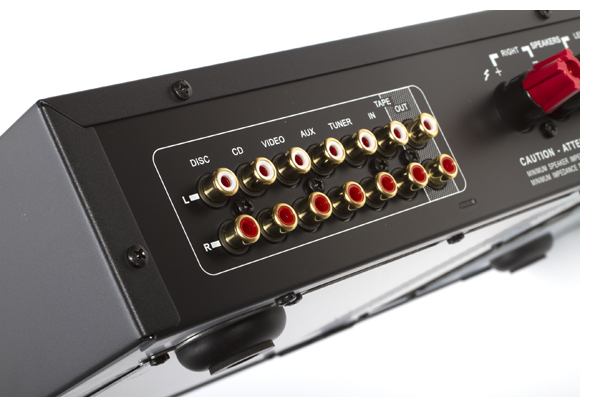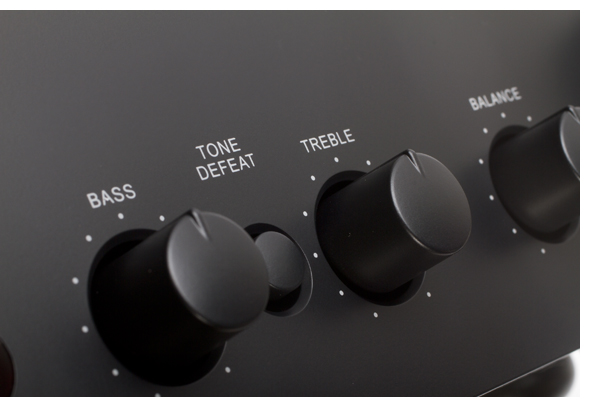NAD C316 BEE Integrated Amplifier Budget Audiophile: An Updated Classic
By Jeff Dorgay The NAD 3020 integrated amplifier was a marvel in its day. While rated at only 20 watts per channel, it boasted a beefy power supply and fair amount of headroom, giving it the ability to drive a wide range of speakers. It also included a bevy of features, not the least of which was a high-quality MM phono preamplifier and “soft clipping” circuit that prevented more than a few tweeters from ruin. All this audio goodness came wrapped in a stark, olive green-tinted black case for just $219.
The NAD 3020 integrated amplifier was a marvel in its day. While rated at only 20 watts per channel, it boasted a beefy power supply and fair amount of headroom, giving it the ability to drive a wide range of speakers. It also included a bevy of features, not the least of which was a high-quality MM phono preamplifier and “soft clipping” circuit that prevented more than a few tweeters from ruin. All this audio goodness came wrapped in a stark, olive green-tinted black case for just $219.
The C316 BEE power is rated at twice that of the 3020 and claims NAD’s latest PowerDrive circuitry from the company’s flagship amplifiers. Tone controls now offer the option to be entirely switched out of the circuit, and an 1/8” jack on the front panel accommodates the high-level output of a portable music player.
As one of many audiophiles with fond memories of the NAD 3020 (an original, not the later A or B version), I had tons of fun bringing one back into the studio for a serious listening session. Mark Stone and the folks at NAD North America gave the 3020 seen in this issue’s Old School section a complete checkup, verifying that it still more than meets its original design specs. Our test sample exceeded the stated 20wpc at 8 ohms rating by a healthy margin, producing 29 wpc at rated distortion. (Steve Guttenberg lends further insights on page 19.)
Still, while the 3020 is a stout amplifier on the bench and in the listening room, time has come to move on to the entry-level NAD integrated. The new model’s form factor remains similar, albeit slightly slimmer. The LEDs follow modern fashion and are blue instead of the red popular in the late 70s. A remote is included in the box. And, adjusted for inflation, the $329 C316 BEE makes for an even monetary better value than the 3020 in the early 80s.
It’s always easy to wax poetic about the past, deluding oneself into thinking that things were better back in the old days. While the 3020’s power meter was constantly pegged driving my Acoustat 2+2’s during the early 80s, it barely broke a sweat powering my current Verity Audio Rienzes, which present a much more benign load. At modest listening levels, neither amplifier caved, but the difference in sound between the two units proved dramatic—and in favor of the old.
Teamed with the Rienze floorstanding speakers and a dCS Paganini stack, and cabled with a full complement of Cardas Clear, the demonstration epitomized what I’ll call audio-foolery. Who in their right mind would mate a couple of $300 integrated amplifiers with $100k worth of ancillaries? Guilty as charged, but the results were telling.
Differences between old and new models are unmistakable. The current amplifier possesses more extension at the upper end of the spectrum, but the vintage unit wins in every other category. The 3020 enjoys a more vivid, almost tube-like midrange, and takes control of the Rienze’s woofers with more authority.
While the C316 BEE is a great little amplifier, the 3020 is a serious piece of audiophile kit. When listening to Thomas Dolby’s “My Brain is Like a Sieve” from Aliens Ate My Buick, the electronic effects have an almost buoyant feel, wafting back and forth across the soundstage. Yet they stay in a single plain when experienced via the C316 BEE. The wet and expansive echo in Tim Curry’s voice on the title track of Simplicity has depth on the 3020, but none on the new amplifier. The most explicit revelation occurred during the intro of Keith Emerson’s “Ignition” from his recent Keith Emerson Band. Where the 3020 reproduces the low organ notes, all is silence when played through the C316 BEE.
A similar verdict is reached listening to Tone Loc’s “Funky Cold Medina.” The C316 BEE just doesn’t have the grunt. The final nail in the coffin came courtesy of the acoustic guitar intro to Tracy Chapman’s “Fast Car.” A tonal richness exists with the 3020 that fools you into thinking a much more expensive amplifier is behind the scenes. No wonder the audiophile press labeled this amplifier a “giant killer.” At modest volume, it more than held its own with the industry’s best when introduced in the early 80s.
When swapping my aforementioned setup for an iPad, Aperion Intimus 5 bookshelf speakers ($599/pair), and Radio Shack capable, the differences between the two amps practically disappeared. But that’s what makes the 3020 so cool: You can hook it up to a pair of $11,000 speakers and be impressed. While the C316 BEE may not ultimately appeal to audiophile sensibilities (and let’s face it, what $329 integrated amplifier does today?), it makes for a great graduation present for a music-loving teenager about to head off to college.
Don’t get me wrong: The NAD C316 BEE represents very good value and performance for the price. Like its predecessor, it serves as a great cornerstone for a budget hi-fi system. If mated with a decent pair of $250-$600 speakers, it’s sure to impress the uninitiated. And if you’ve never experienced a 3020 in great shape, you’ll probably be bowled over by the C316 BEE.
The idea of a brand-spanking new amplifier with no scratches or fingerprints, as well as a warranty, will likely appeal to 99.9% of listeners that would rather not take the chance of getting an abused relic. 3020s usually got passed on from friend to friend, creating a lot of audiophile goodwill. But more often than not, they gathered numerous abrasions in the process. However, if you do happen to stumble across a mint 3020, buy it.
Removing the cover of the C316 BEE reveals a tidy layout that’s a model of simplicity, with a large toroidal transformer and beefy heat sink for the power amplifier’s output stage. By comparison, the 3020 looks like someone emptied a colander of pasta on the circuit board. And the C316 BEE does have a remote, so progress isn’t all bad.
Besides, the NAD C316 BEE offers everything you need around which to build a great budget hi-fi system. It sounds good, fits nearly anywhere, and offers much better sound than what local big-box bandits sell for the same amount of money. Will it shift millions of units like its predecessor, and end up in dorm rooms everywhere? We can only hope.





